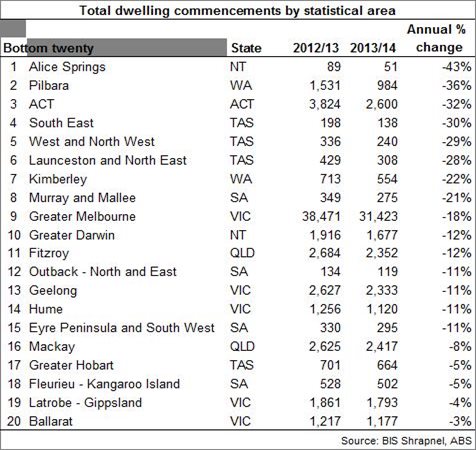Key pockets around Australia are set for a building boom, helped by local population growth, according to industry analyst and economic forecaster, BIS Shrapnel.
However, they also predict public sector cutbacks and the cooling mining sector will lead to a dramatic drop in dwelling commencements in some other pivotal localities.
In its new Regional Building 2013-2015 report, which provides the latest forecasts for residential and non-residential building activity by local area nationwide, BIS Shrapnel identifies the Top 20 regions that are forecast to thrive over the next few years – and the Bottom 20 where home building will stagnate.
At the top of the league table is the Coffs Harbour-Grafton area, which is forecast to see building grow by 52 per cent next year.
“Coffs Harbour-Grafton hugs the coast towards the north of New South Wales, sandwiched between Richmond-Tweed and the Mid-North Coast. It has an older age profile, with a median age of 44 compared to 38 across the state as a whole, and has a significant lifestyle and retiree component to demand,” says Kim Hawtrey, Associate Director of BIS Shrapnel.
“After the Global Financial Crisis home building in the region dropped, an experience shared with many similar destinations, and now we find there is an undersupply of homes. According to the report, growth will return to areas such as Coffs Harbour-Grafton in 2013/14 and beyond, taking activity back towards the pre-GFC levels.”

A similar story applies to several other regions on the New South Wales North Coast, such as Richmond-Tweed (forecast to see home building grow 24%) and Newcastle-Lake Macquarie (+19%).
Queensland has a number of local areas in the Top 20, notably lifestyle locations such as Wide Bay and Toowoomba.
“The Wide Bay region lies just above the Sunshine Coast and includes the major regional cities of Bundaberg, Gympie, Hervey Bay and Maryborough. The region is a lifestyle location with tourism being a key industry in the local economy,” says Hawtrey.
“We expect continued strong economic activity to drive a pick up in home construction in regions such as Wide Bay (forecast to be up 16 per cent) and Toowoomba (up 12 per cent) in 2013/14 and beyond.”
In Western Australia, the building focus is predicted to shift strongly towards the southern half of the state, especially the south west corner.
The Wheat Belt (forecast to grow by 29 per cent), Esperance (+27 per cent), and Bunbury (+27 per cent) all feature in the Top 20 regions based on their outlook for growth in dwelling commencements.
“Bunbury, Esperance and the Wheat Belt cover the south-west corner of the state, including the Margaret River wine region and Manjimup,” says Hawtrey. “The area includes a number of manufacturing operations as well as a local tourism industry and a lifestyle component of demand. A new rail link to Mandurah is promising to open up the region.”
Kim Hawtrey suggested the residential building in these parts had descended in recent years as the region’s tourism and manufacturing industries suffered with the stronger dollar and weakened property markets post-GFC.
“Looking ahead, the contraction appears to have bottomed and we expect to see growth in dwelling commencements return, with multi-residential style dwellings in particular improving from extreme lows,” says Hawtrey. “Low interest rates, a friendlier exchange rate, and improving confidence will drive increased building activity.”
Elsewhere in Western Australia, the cooling mining sector is expected to hit construction in resource regions such the Pilbara and the Kimberley. Both regions make it into BIS Shrapnel’s Bottom 20 list of regions by building outlook in its Regional Building 2013-2015 report.

The Pilbara region has been the epicentre of the state’s mining boom with a number of massive projects driving strong economic growth across the region.
Until recently, the significant investment pipeline in the Pilbara has driven strong employment and population growth, and residential building in 2012/13 will see activity reach a new peak of over 1,500 dwellings as building in Karratha, Port Hedland and South Hedland has continued at a strong pace.
According to the Regional Building 2013-2015 report, however, from this unsustainable level, heavy declines should be expected, although activity will remain high by pre-boom standards.
With mining investment in the region estimated to have peaked, home building in 2013/14 is forecast to contract by 36 per cent in the Pilbara and 22 per cent in the Kimberley.
But the worst performing regions are predicted to be in the south-east corner of the country.
In Victoria, areas hit by recent factory closures such as Geelong (projected to be down 11 per cent) and Hume (-11 per cent) will record a drop off in home building.
The ACT will suffer from public sector cutbacks and see a dramatic 32 per cent reduction in dwelling commencements.
A number of key regions in South Australia and Tasmania face a dismal period ahead, with projected falls in home building ranging from five per cent (Fleurieu-Kangaroo Island) to as high as 30 per cent (South-East Tasmania).

